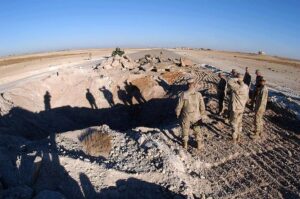(This is section 29 of the World Beyond War white paper A Global Security System: An Alternative to War. Continue to preceding | following section.)

Realign military spending, convert infrastructure to produce funding for civilian needs!
(Please retweet this message, and support all of World Beyond War’s social media campaigns.)
Demilitarizing security as described above will eliminate the need for many weapons programs and military bases, providing an opportunity for government and military-dependent corporations to switch these resources to creating genuine wealth by operating in the private sector in line with free market principles. It can also reduce the tax burden on society and create more jobs. In the U.S., for every $1 billion spent in the military more than twice the number of jobs would be created if the same amount were spent in the civilian sector.note32 The trade-offs from shifting federal spending priorities with US tax dollars away from the military toward other programs are tremendous.note33

Spending on a militarized national “defense” is astronomical. The United States alone spends more than the next 15 countries combined on its military.note34
The United States spends $1.3 trillion dollars annually on the Pentagon Budget, nuclear weapons (in the Energy Department budget), veteran’s services, the CIA and Homeland Security.note35 The world as a whole spends over $2 trillion. Numbers of this magnitude are hard to grasp. Note that 1 million seconds equals 12 days, 1 billion seconds equals 32 years, and 1 trillion seconds equals 32,000 years. And yet, the highest level of military spending in the world was unable to prevent the 9/11 attacks, nuclear proliferation, to end terrorism, or to bring democracy to Iraq or peace to the Middle East. No matter how much money is spent on war, it no longer works.
Military spending is also a serious drain on a nation’s economic strength, as pioneering economist Adam Smith pointed out. Smith argued that military spending was economically unproductive. Decades ago, economists commonly used “military burden” almost synonymously with “military budget.” Currently, military industries in the U.S. receive more capital from the State than all private industries combined can command. The combined Pentagon budgets exceed the net profits of all U.S. corporations. Transferring this investment capital to the free market sector either directly by grants for conversion or by lowering taxes or paying down the national debt (with its huge annual interest payments) would inject a huge incentive for economic development. A Security System combining the elements described above (and to be described in following sections) would cost a fraction of the present military budget and would underwrite a process of economic conversion. Furthermore, it would create more jobs. One billion dollars of federal investment in the military creates 11,200 jobs whereas the same investment in clean energy technology would yield 16,800, in health care 17,200 and in education 26,700.note36

The main obstacles to economic conversion are the fear of job loss and the need to retrain both labor and management. Jobs will need to be guaranteed by the State while the retraining takes place, or other forms of compensation paid to those currently working in the military industry in order to avoid a negative impact on the economy of major unemployment during the transition from a war to a peacetime status. Management will need to be retrained as they go from a command economy to a free market economy.
To be successful, conversion needs to be part of a larger political program of arms reduction and it will require national level meta-planning and financial assistance and intensive local planning as communities with military bases envision transformation and corporations determine what their new niche can be in the free market. This will require tax dollars but in the end will save far more than is invested in redevelopment as states end the economic drain of military spending and replace it with profitable peace time economies creating useful consumer goods.
Attempts have been made to legislate conversion, such as the Nuclear Disarmament and Economic Conversion Act of 1999, which links nuclear disarmament to conversion.
The bill would require the United States to disable and dismantle its nuclear weapons and to refrain from replacing them with weapons of mass destruction once foreign countries possessing nuclear weapons enact and execute similar requirements. The bill also provides that the resources used to sustain our nuclear weapons program be used to address human and infrastructure needs such as housing, health care, education, agriculture, and the environment. So I would see a direct transfer of funds.
(Transcript of July 30, 1999, Press Conference) HR-2545: “Nuclear Disarmament and Economic Conversion Act of 1999″
Legislation of this sort requires more public support to pass. Success may grow from a smaller scale. The state of Connecticut has created a commission to work on transition. Other states and localities may follow Connecticut’s lead.
(Continue to preceding | following section.)

We want to hear from you! (Please share comments below)
How has this led you to think differently about alternatives to war?
What would you add, or change, or question about this?
What can you do to help more people understand about these alternatives to war?
How can you take action to make this alternative to war a reality?
Please share this material widely!
Related posts
See other posts related to “Demilitarizing Security”
See full table of contents for A Global Security System: An Alternative to War
Notes:
32. A draft sample treaty to achieve this can be seen at the Global Network for the Prohibition of Weapons and Nuclear Power In Space, at http://www.space4peace.org. (return to main article)
33. Researchers found that investments in clean energy, health care and education create a much larger number of jobs across all pay ranges than spending the same amount of funds with the military. For the complete study see: The U.S. Employment Effects of Military and Domestic Spending Priorities: 2011 Update. (return to main article)
34. Try the interactive trade-offs calculator tool developed by the National Priorities Project. (return to main article)
35. See the Stockholm International Peace Research Institute Military Expenditure Database. (return to main article)
36. Download the War Resisters League federal spending pie chart at https://www.warresisters.org/sites/default/
files/2015%20pie%20chart%20-%20high%20res.pdf (return to main article)









One Response
Global Day of Action on Military Spending – April 13, 2015 – http://demilitarize.org/ – WORKS FOR ME!